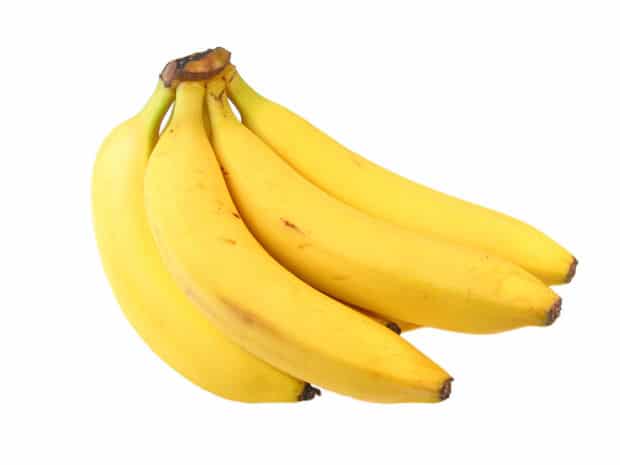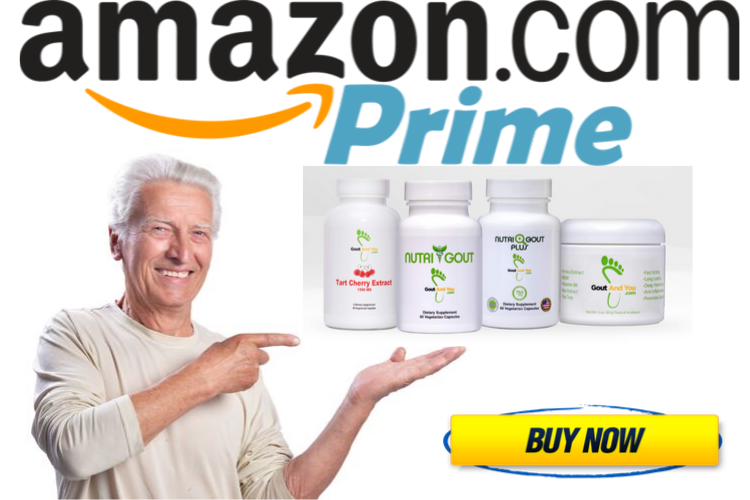
Bananas are low in purines and high in vitamin C which studies have shown can help to lower uric acid levels. But bananas also contain fructose which is known to contribute to increased uric acid. So should you be eating bananas with gout? Read on to discover why you should.
Bananas and Gout
According to Wikipedia the banana is ‘technically’ a berry…
“The banana is an edible fruit, botanically a berry, produced by several kinds of large herbaceous flowering plants in the genus Musa. In some countries, bananas used for cooking may be called plantains. The fruit is variable in size, color and firmness, but is usually elongated and curved, with soft flesh rich in starch covered with a rind which may be green, yellow, red, purple, or brown when ripe. “
Bananas are rich in health-giving vitamins and minerals, such as fiber, folate, potassium, manganese, vitamin B6, vitamin C and more. And they’re low in sodium. It’s believed the nutrients in bananas may help to support heart health, reduce the risk of diabetes, manage blood pressure, aid digestion, and aid in exercise recovery.
There is a downside however; they’re relatively high in sugar…
According to the USDA National Nutrient Database, one medium-sized banana contains around 14g of sugar (fructose, glucose, sucrose, and maltose) and 105 calories.
And, being a carbohydrate, sugar produces calories; 4 calories per gram of sugar. So the sugar in a medium banana will produce around 56 calories which is 53% of its calorific content. In other words, more than half of a banana is sugar!
Bear in mind, though, it’s natural sugar ‘surrounded’ by healthy nutrients, unlike the man-made sugar found in commercial foods and beverages which is calorie dense and has no nutritional value.
That being said it’s still sugar and too much can still be bad for you. But this can be mitigated by consuming bananas in moderation. Most experts recommend eating no more than 2 medium bananas a day in a healthy, varied, balanced diet.
But, is it safe to eat even just 2 medium bananas with gout?
Let’s take a look at gout…
Gout is a very painful type of arthritis caused by too-high levels of uric acid in the bloodstream. Over time, microscopic uric acid crystals can form out of the acid and settle in the joints and surrounding tissue.
It’s the body’s own natural inflammatory response to these crystals that causes the sudden, intensely painful reaction in the joint that we call a gout flare or gout attack.
Typical gout symptoms are: inflammation, swelling, tight shiny red skin over the joint, warm / hot to the touch, stiffness, and acute pain.
So when we talk about the symptoms of gout we’re really referring to the symptoms associated with gout flare-ups, which occur most often in the big toe, although any joint can be affected. In a minority of cases some gout patients may even suffer polyarticular attacks, meaning gout flares in more than one joint at the same time.
Uric Acid
Uric acid is a waste product of purine metabolism. Purines are natural compounds found in our bodies’ cells and in the cells of the food we eat; both animal and plant-based. Purine compounds in food break down during the digestive process, producing uric acid as a byproduct.
Excess uric acid is normally excreted in urine via the kidneys but when the body produces too much uric acid, or the kidneys can’t excrete it fast enough, there’s a build-up of uric acid in the blood and a corresponding increased risk of gout attacks.
Purines in Food
Different foods have different purine concentrations: there are foods with high purine concentrations, some with moderate amounts of purine, and many with a low purine content. High-purine foods will produce more uric acid than moderate-purine foods and moderate-purine foods will produce more uric acid than low-purine foods, when consumed in equal quantities,
So gout patients are generally encouraged to change to a low-purine diet which completely avoids high-purine foods, such as organ meats; limits moderate-purine foods, like red meat; and allows low-purine foods, like plenty of vegetables, fresh fruits, low-fat dairy products, whole grains, etc.
Are Bananas Safe to Eat with Gout?
Purines in Bananas
Purines in bananas produce 57mg of uric acid per 100g of banana, which is considered low and safe for gout sufferers.
Bananas may even have a positive effect on the condition:
- Bananas are a rich source of vitamin C which studies have associated with lowered uric acid and a reduced risk of gout. It also has anti-inflammatory properties.
- They’re also very high in potassium which is beneficial for gout since studies show that potassium deficiency can raise uric acid levels.
- Bananas are alkaline forming when eaten and studies show that alkalizing urine through diet aids in the removal of uric acid from the body.
On the face of it, then, bananas are safe in a healthy gout diet…
However, as well as purine content, we gout sufferers have to be mindful of fructose since it, too, is a risk factor for gout. Studies show that high fructose consumption, especially in sugary drinks and sodas, helps to increase uric acid production.
Fructose — sometimes called ‘fruit sugar’ — is a simple sugar found in nature, for example, in honey, fruits, berries, and vegetables. It’s also added, usually in the form of man-made high fructose corn syrup, to a wide range of commercial food and drink products as a taste enhancer.
Let’s look at the fructose content of bananas…
Fructose in Bananas
Bananas contain an average of 7.2g of fructose per 100g serving, according to the Food Intolerance Network.
Unfortunately, it’s difficult to quantify how much uric acid a given amount of fructose in fruit can produce since fructose raises uric acid levels through several mechanisms, for example, by suppressing uric acid excretion.
In fact, I haven’t been able to find any fructose-uric acid food tables. I’m not saying they don’t exist, it’s just that I haven’t found any. On the other hand there are several purine-uric acid food tables out there.
What we can do, though, is compare bananas’ fructose content with other fruits.
Fructose in bananas (7.2g / 100g) is higher than in fruits such as:
- sour cherries (3.9g)
- plums (3.9g)
- raspberries (3.1g)
- oranges (4.4g)
- pineapple (5.1g)
- kiwi fruit (5.2g)
- strawberries (2.9g)
but less than things like:
- jackfruit (9.4g)
- red/green grapes (8.2g)
- sweet cherries (12g)
- mango (8.2g)
- pomegranate (8.5g)
and about the same as:
- apples (6.9g)
- pears (7.2g)
[For reference, honey has 40.2g and maple syrup 29.8g per 100g serving.]
So bananas look to be somewhat high in fructose compared to some other popular fruits, although much the same as apples and pears.
However, experts remind us that any risk needs to be balanced against bananas’ overall nutritional and health benefits and, as we saw earlier, that can be achieved through moderating consumption.
On balance, then, bananas are a healthy addition to a gout-friendly diet. But, to reduce potential hazards from sugar (including fructose), stick to no more than two medium-sized bananas a day.



